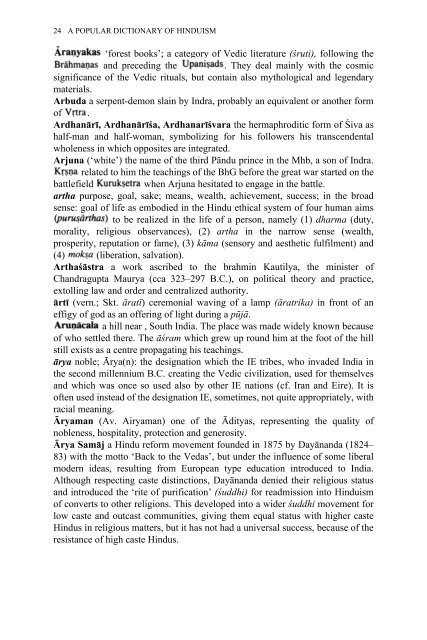You also want an ePaper? Increase the reach of your titles
YUMPU automatically turns print PDFs into web optimized ePapers that Google loves.
24 A POPULAR DICTIONARY OF HINDUISM<br />
‘forest books’; a category <strong>of</strong> Vedic literature (śruti), following the<br />
and preceding the . They deal mainly with the cosmic<br />
significance <strong>of</strong> the Vedic rituals, but contain also mythological and legendary<br />
materials.<br />
Arbuda a serpent-demon slain by Indra, probably an equivalent or another form<br />
<strong>of</strong> .<br />
Ardhanārī, Ardhanārīśa, Ardhanarīśvara the hermaphroditic form <strong>of</strong> Śiva as<br />
half-man and half-woman, symbolizing for his followers his transcendental<br />
wholeness in which opposites are integrated.<br />
Arjuna (‘white’) the name <strong>of</strong> the third Pāndu prince in the Mhb, a son <strong>of</strong> Indra.<br />
related to him the teachings <strong>of</strong> the BhG before the great war started on the<br />
battlefield<br />
when Arjuna hesitated to engage in the battle.<br />
artha purpose, goal, sake; means, wealth, achievement, success; in the broad<br />
sense: goal <strong>of</strong> life as embodied in the Hindu ethical system <strong>of</strong> four human aims<br />
to be realized in the life <strong>of</strong> a person, namely (1) dharma (duty,<br />
morality, religious observances), (2) artha in the narrow sense (wealth,<br />
prosperity, reputation or fame), (3) kāma (sensory and aesthetic fulfilment) and<br />
(4) (liberation, salvation).<br />
Arthaśāstra a work ascribed to the brahmin Kautilya, the minister <strong>of</strong><br />
Chandragupta Maurya (cca 323–297 B.C.), on political theory and practice,<br />
extolling law and order and centralized authority.<br />
ārtī (vern.; Skt. āratī) ceremonial waving <strong>of</strong> a lamp (āratrika) in front <strong>of</strong> an<br />
effigy <strong>of</strong> god as an <strong>of</strong>fering <strong>of</strong> light during a pūjā.<br />
a hill near , South India. The place was made widely known because<br />
<strong>of</strong> who settled there. The āśram which grew up round him at the foot <strong>of</strong> the hill<br />
still exists as a centre propagating his teachings.<br />
ārya noble; Ārya(n): the designation which the IE tribes, who invaded India in<br />
the second millennium B.C. creating the Vedic civilization, used for themselves<br />
and which was once so used also by other IE nations (cf. Iran and Eire). It is<br />
<strong>of</strong>ten used instead <strong>of</strong> the designation IE, sometimes, not quite appropriately, with<br />
racial meaning.<br />
Āryaman (Av. Airyaman) one <strong>of</strong> the Ādityas, representing the quality <strong>of</strong><br />
nobleness, hospitality, protection and generosity.<br />
Ārya Samāj a Hindu reform movement founded in 1875 by Dayānanda (1824–<br />
83) with the motto ‘Back to the Vedas’, but under the influence <strong>of</strong> some liberal<br />
modern ideas, resulting from European type education introduced to India.<br />
Although respecting caste distinctions, Dayānanda denied their religious status<br />
and introduced the ‘rite <strong>of</strong> purification’ (śuddhi) for readmission into <strong>Hinduism</strong><br />
<strong>of</strong> converts to other religions. This developed into a wider śuddhi movement for<br />
low caste and outcast communities, giving them equal status with higher caste<br />
Hindus in religious matters, but it has not had a universal success, because <strong>of</strong> the<br />
resistance <strong>of</strong> high caste Hindus.


















